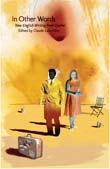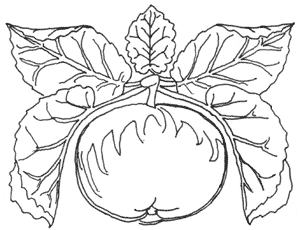If I were in Montreal tomorrow evening, Wednesday, November 11, from 5 pm to midnight, I would be at Librairie Le Port de Tête (262 Mont-Royal E) for the long awaited launch of Le Livre de Chevet. In English, this book might go by the name The Bedtime Book of Falling Asleep. In it are gathered powerfully hypnotic, narcotic and somnambulic texts from 24 writers. I have contributed a text called Les huits quartiers de sommeil. Those of you already familiar with La Table de Matières productions (design by Feed) will have an inkling of how gorgeous this book is. www.latabledesmatieres.com
Le mercredi 11 novembre prochain, de 17h00 à minuit, LE LIVRE DE CHEVET, troisième et ultime ouvrage de la collection La table des matières, apparaîtra de ce côté ci du sommeil, au Port de tête, librairie sise au 262, Avenue du Mont-Royal Est. Il est publié à l’enseigne du Quartanier.
Vous êtes conviés à son lancement, qui est aussi celui de deux ouvrages amis, et anglais, EXPEDITIONS OF A CHIMAERA, livre bicéphale de Oana Avisilichioaei et Erin Moure, et THE ROSE CONCORDANCE, d’Angela Carr, tous deux publiés par l’éditeur torontois BookThug. Si LE LIVRE DE CHEVET était anglais, il s’intitulerait THE BEDTIME BOOK OF FALLING ASLEEP, mais non.
Quelques précisions et encouragements: il y a deux années et demi que je travaille à la réalisation, avec mes complices du studio FEED, du LIVRE DE CHEVET. L’ouvrage, qui fait suite à CITÉ SELON, sur la ville (il faut bien habiter quelque part) et LA TABLE DES MATIÈRES, sur la nourriture (il est mieux de manger quelque chose) est encore une fois consacré à un sujet véritablement universel, accessible à tous, grand public et tout : dormir. Les deux ouvrages précédents se sont mérités quelques trophées de design, ce qui aide ou n’aide pas les ventes, on ne le sait pas vraiment.
Lorsqu’elle se penche sur des sujets d’intérêt public comme le sommeil, la littérature, contrairement à ce que l’élite populiste voudrait nous faire croire, apparaît comme l’affaire de tout le monde. Vous entendez le langage passer en vous? Maintenant, voyez comme il peut avoir fière allure, lorsque vous vous y attardez un peu plus. D’ailleurs, le conseil d’administration de La table des matières croit fermement que tout le monde, et surtout les insomniaques, peut trouver son compte dans LE LIVRE DE CHEVET: le livre, dont le papier est doux comme la lumière d’une veilleuse, plaira même à ceux qui préfèrent ne pas lire.
LE LIVRE DE CHEVET, comme une princesse de conte, a sommeillé longtemps, s’additionnant peu à peu la substance rêvée de 24 textes, librement associés à 12 collages (Annie Descôteaux) et 12 dessins (Pol Turgeon), 2 paysages improbables (Annie D et Pol T), 2 schémas, 4 photos (Daniel Canty) et 24 calligraphies (Léon Lo), le tout distribué sur 240 pages dont la substance emprunte à celles du jour et de la nuit. Vous verrez. Les littérateurs vous l’avaient dit: la nuit est parfois d’encre. Et on verra, grâce au LIVRE DE CHEVET, qu’elle sait tomber partout, même entre les pages d’un livre. Les fantasmes d’un pornocrate sans emploi, dans un cahier à la tranche scellée, étanche à la curiosité infantile (sauf si l’enfant est habile et sait manier le couteau), complètent le tout.
LE LIVRE DE CHEVET ressemble à un livre pour enfant qui aurait grandi, mais qui se souvient, oh se souvient, des nuits passées à rêver la vie à venir, à la lumière d’une lampe de poche.
La lumière est comme de l’encre.
Tout ce que je dis est vrai.
Vous êtes des dormeurs.
Soyez des nôtres.
//Lancement//
–
LE LIVRE DE CHEVET
EXPEDITIONS OF A CHIMAERA
THE ROSE CONCORDANCE
–
De 17h à minuit, le mercredi 11 novembre,
au Port de Tête, 262, Mont-Royal est
Lectures entre 19h et 20h
Concert de fin de soirée: 44 Ensemble
–
Visitez www.latabledesmatieres.com
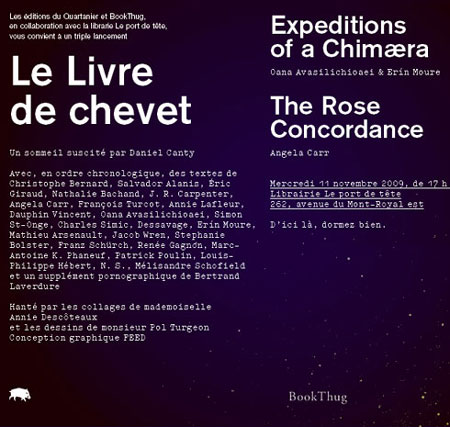
. . . . .
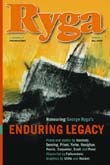 Three of my short stories appear in the inaugural issue of Ryga: A journal of Provocations, a new publication of The Ryga Initiative at Okanagan College, in association with the Okanagan Institute.
Three of my short stories appear in the inaugural issue of Ryga: A journal of Provocations, a new publication of The Ryga Initiative at Okanagan College, in association with the Okanagan Institute.
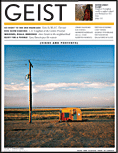 I love
I love 
